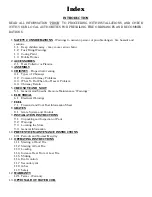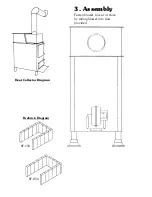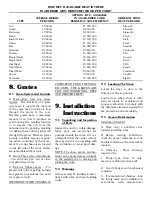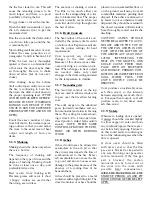
8
build-up has occurred.
If creosote has accumulated, it
should be removed to reduce the
risk of a chimney fire.
If an over-fire situation should occur,
be sure ash door and fire door are
closed.
In the event of a soot fire, call your
fire department immediately, and
make sure the ash door, fire door
and drafts are closed.
6. Electrical
6.1 Wa rn i n g s
Turn off electric power at fuse box
or circuit breaker panel before mak-
ing any line voltage connections.
Follow local electrical codes. Be
sure to route power so that it does-
n’t come in contact with the stove.
I M P O RTA N T!
ALL
WIRING
SHOULD BE DONE IN ACCOR-
DANCE WITH LOCAL AND
STATE CODES.
7. Fuel
7.1 F i rewood and Coal Fuel
I n f o rmation Sheet
The energy content of most hard-
woods, and all but a few softwoods,
is generally estimated to be around
8,6000 BTU’s per pound at zero
p e rcent moisture content. This,
however, would not be a practical
value to use in the calculation of fuel
needed to meet a given heat load.
All the BTU’s available in wood are
not generated as usable, sensible
heat. Much of this heat is dependent
on the appliance’s efficiency and is
required in the venting system to
generate a draft. Also, firewood is
not available at zero percent mois-
ture. Well seasoned, sheltered wood
contains an approximate minimum
moisture of 20%, where the same
wood left to the elements may have
a moisture content as high as 80%.
One cubic foot of hardwood weighs
about 45 pounds. One cubic foot of
water weighs 62.5 pounds, and the
amount of energy required to evap-
orate only one pound of this water
is over 1,000 BTU’s. If the same
cubic foot of hardwood has a mois-
ture content of 80%, it would weigh
approximately 80 pounds, and the
energy lost in boiling off this mois-
ture could theoretically be as high as
35,000 BTU’s, not to mention a
sore back from carrying the soggy
stuff.
In summary, burn only well-sea-
soned dry wood. Wood must not
only be of a reasonable quality and
seasoned, but to get its maximum
heat energy output, it must be dry.
S e a s o n i n g - unseasoned (gre e n )
wood, when used as fuel, offers
many potential problems. It is of
course much heavier than seasoned
wood because of its high moisture
content. When burned, it loses
much of its heat value in boiling off
this moisture. It is difficult to ignite
and is sometimes hard to keep burn-
ing. But its major evil is creosote, as
will be discussed in the next section.
Seasoning is easy! The cutting,
stacking, and putting it under cover
is the hard part; but once this is
done, just leave it alone. leave it
alone for at least one year -- better
two. If wood is cut in the dead of
winter, little seasoning takes place
until the temperature rises above
f reezing. If the wood is store d
unprotected, minimal seasoning can
occur. Moisture from high humidity,
rain, snow, dew, etc., will be
absorbed into the wood and then
must be evaporated before the sea-
soning process can begin again. If
you live in an area where the win-
ters are long and hard, you can
expect your wood to take longer to
season than wood stored in a more
temperate climate. However, as
wood is susceptible rot, it can be
stored too long. Rotten wood con-
tains less heat energy than good
wood, so the more advanced the
rotting, the less BTU’s can be
derived from the fuel.
Choosing a kind of firewood to burn
in your stove naturally depends on
what is available to you. If all you
can obtain is softwood, obviously,
that will be your choice.
Softwoods like pine, spruce, and fir
are easy to ignite because they are
resinous. They burn rapidly with a
hot flame. However, since a fire
built entirely of softwoods burns out
quickly, it requires frequent atten-
tion and replenishment.
This characteristic of softwoods can
be a boon, if you want a quick
warming fire or a short fire that will
burn out before you go to bed.
If you do have a choice, for a long
lasting fire, it is best to use the heav-
ier hardwoods such as ash, beech,
birch, maple and oak.
By mixing softwoods with hard-
woods, you can achieve an easily
ignited and long lasting fire.
So that you have an idea of how
firewood is described and sold, you
should first know that the most
common measure is the standard
cord. A cord is a well-stacked pile of
logs 4 ft. by 4 ft. by 8 ft. Wood is
also sold by the ton.
If you buy wood by weight, look for
the driest wood. Don’t pay for extra
water! Small twigs and branches
found in your yard and wood wastes
found around sawmills are also
good. When you buy wood, request
a mixture of wood species and
diameter sizes. the wood should be
generally sound, but don’t worry
about small pockets of rotten wood
that you may find in logs.
Содержание SF-150 SF-250
Страница 18: ...17...





































